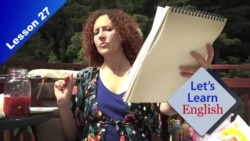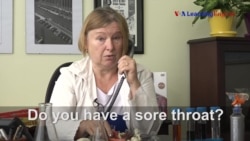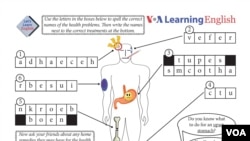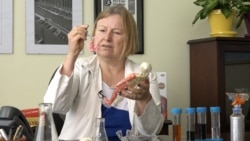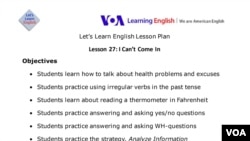Lesson 27: I Can't Come In
Let’s Learn English เปิดโอกาสการเรียนรู้และฝึกทักษะภาษาอังกฤษ ในรูปแบบที่ถูกออกแบบโดยผู้เชี่ยวชาญตามมาตรฐานการศึกษาของอเมริกา เพื่อให้เนื้อหาเหมาะสำหรับผู้เริ่มเรียนภาษาอังกฤษ
เรานำเสนอ 52 บทเรียน และทุกๆ 5 บทเรียน จะมีการทบทวนสิ่งที่เรียนไปแล้ว
ทุกสัปดาห์จะมีบทเรียนใหม่ พร้อมด้วยวิดีโอ ที่สะท้อนชีวิตชาวอเมริกันรุ่นใหม่ ผู้เรียนจะได้ฝึกการพูด เขียน และจดจำคำศัพท์
นอกจากนั้นผู้เรียนสามารถพิมพ์บทเรียนที่ทำแล้ว ผลการฝึกฝน และแผนการฝึกเรียนภาษาอังกฤษในบทต่อๆ ไปได้
เราอยากให้คุณติดตามบทเรียนใหม่ๆ ทุกสัปดาห์ และบอกให้เรารู้ถึงการเรียนรู้ของคุณผ่านการแสดงความคิดเห็น (comment) และอีเมล์ของเราที่ thai@voanews.com
เรื่องย่อ
แอนนารู้สึกไม่ค่อยสบาย เธอจึงตัดสินใจโทรหาเจ้านายและคุณหมอ พวกเขาจะบอกให้เธอทำอะไรบ้าง? และแอนนาจะทำตามที่พวกเขาแนะนำหรือไม่?
ฝึกพูด
ฝึกการพูดคำศัพท์ใหม่ในบทเรียนนี้ คุณสามารถเรียนรู้เกี่ยวกับการผันกริยาในรูปอดีตในแบบไม่ปกติ
ฝึกออกเสียง
ใช้วิดีโอนี้ในการเรียนรู้เกี่ยวกับการถาม 2 ประเภท คือ WH-Question ได้แก่ What When Where Why Who Which และ How และ Yes/No Question หรือคำถามที่ต้องการคำตอบแค่ ใช่ หรือ ไม่ใช่
บทสนทนา
Anna: Hello! I am sure that today, in Washington, D.C,. there are a lot of great things to do. But I am not doing any of them. I am sick. Right now, I'm going to call my boss and tell her I cannot come in to work.
Caty: Hello?
Anna: Ms. Weaver, Hi. I can’t come to work today.
Caty: Why not? What is wrong?
Anna: Well, yesterday I felt fine.
Anna: In the morning, I painted for hours. In the afternoon, I cut wood. Then, I built a fire.
Caty: Anna, what do you mean? Why can’t you come to work today?
Anna: I do not feel well. I think I’m sick.
Caty: I’m sorry to hear that. I was sick last week, too. I had the flu.
Anna: (sneezes) What did you do?
Caty: I slept a lot and I drank a lot of water. Do you have a doctor?
Anna: Yes, I do.
Caty: You should call your doctor. And get lots of rest!
Anna: Thanks, Ms. Weaver. I’ll call right now. I'm calling my doctor.
Dr. Bennett: (to herself) Now, where does this thing go?
Dr. Bennett: Hello. This is Dr. Bennett. How can I help you?
Anna: Hello, Dr. Bennett. This is Anna.
Dr. Bennett: Oh, Hi, Anna. How can I help you?
Anna: I think I’m sick.
Dr. Bennett: Let me ask you a couple of questions. Do you have a sore throat?
Anna: Yes. I have a sore throat.
Dr. Bennett: Do you have a cough?
Anna: Yes. I have a cough.
Dr. Bennett: When did you start feeling sick?
Anna: This morning. Yesterday I felt great. In the morning I painted, for hours - in the afternoon I cut wood -
Dr. Bennett: Excuse me, Anna. But I don’t need to know all that. Do you have a fever?
Anna: Oh. My thermometer says 125 degrees?! What??
Dr. Bennett: Yeah, that’s not right.
Anna: Oh. Wait. The thermometer was in my hot cup of coffee.
Dr. Bennett: Please take it again, Anna.
Anna: Okay, the thermometer says 100.5 degrees.
Dr. Bennett: 100.5 degrees is not too high. I want you to drink lots of water. Rest in bed and get lots of sleep.
Anna: That is what my boss said to do. Um, Dr. Bennett, when can I go to work?
Dr. Bennett: Don’t go to work for a couple of days.
Anna: Yes! I mean, I don’t want to make my co-workers sick.
Dr. Bennett: That’s right. Call me back in a couple of days.
Anna: I will, Dr. Bennett. And thanks.
Anna: Well, you heard the doctor – no work for a couple of days. I need water, sleep and um … lots of movies! Well, the doctor didn’t say anything about movies. But it can’t hurt! Until next time!
ฝึกเขียน
เกิดอะไรขึ้นบ้างเมื่อคุณเป็นหวัด? และครอบครัวของคุณมีวิธีพิเศษในการทำให้หายดีหรือเปล่า? อีเมลหาเรา หรือเขียนที่ช่องแสดงความเห็นด้านล่าง
คลิกที่ภาพด้านล่าง เพื่อดาวน์โหลดเอกสารประกอบการเรียน และฝึกพูดเกี่ยวกับปัญหาด้านสุขภาพกับเพื่อนๆ
กลยุทธ์การเรียนรู้แบบลัด
Learning Strategies หรือ กลยุทธ์การเรียนรู้ คือความคิด ความตั้งใจ และการกระทำ ที่ช่วยให้การเรียนง่ายขึ้น หรือมีประสิทธิภาพมากขึ้น
กลยุทธ์การเรียนรู้ของตอนนี้ คือ การวิเคราะห์ข้อมูล (Analyze Information)
เมื่อเราเรียนรู้ภาษาที่สอง เราจะต้องคิดให้รอบคอบเกี่ยวกับข้อมูลที่เราได้เรียนรู้ และตัดสินใจ และนั่นคือความหมายของการวิเคราะห์ข้อมูล
ในคลิปวิดีโอนี้ ดร.เบนเน็ตต์ ถามแอนนาหลายคำถาม เมื่อเธอเริ่มวิเคราะห์ข้อมูลที่ได้รับ เธอจึงบอกแอนนาว่าให้อยู่บ้าน ดื่มน้ำ และนอนพัก
คุณสามารถหาช่วงเวลาในคลิปนี้ ที่เห็นการวิเคราะห์ข้อมูลเกิดขึ้นบ้างหรือเปล่า? เขียนหาเราในช่องแสดงความเห็น หรือ อีเมลหาเรา
สำหรับครูผู้สอน คลิกที่ Lesson Plan สำหรับกลยุทธ์การสอนในบทเรียนนี้
แบบทดสอบความเข้าใจด้วยการฟัง
ทดสอบความเข้าใจในบทเรียนนี้ด้วยแบบทดสอบการฟัง คลิกที่วิดีโอนี้ และเลือกคำตอบที่ดีที่สุด
Quiz - Lesson 27
Start the Quiz to find out
______________________________________________________________
คำศัพท์ใหม่
cough - n. the act of forcing air through your throat with a short, loud noise often because you are sick
doctor - n. a person who is skilled in the science of medicine
fever - n. a body temperature that is higher than normal
fire - n. the light and heat and especially the flame produced by burning
flu - n. a common disease that is caused by a virus and that causes fever, weakness, body aches, and breathing problems; also called influenza
rest -v. to stop doing work or an activity
sick - adj. affected with a disease or illness; ill
sneeze - v. to suddenly force air out through your nose and mouth with a usually loud noise because your body is reacting to dust or a sickness
sore - adj. feeling or affected by pain
thermometer - n. an instrument used for measuring temperature
throat - n. the tube inside the neck that leads to the stomach and lungs
wood - n. the hard substance that makes up the stems and branches of trees and shrubs
Past Tense Verbs
cut / cut - v. to use a sharp tool (such as a knife) to open or divide (something, such as paper or wood)
do / did - v. to perform an action or activity
drink / drank - v. to take a liquid into your mouth and swallow it
feel / felt - v. used to describe someone's physical or mental state
hear / heard - v. to be aware of (sound) through the ear
hurt / hurt - v. to be a source or cause of pain
paint / painted - v. to cover (something) with paint or to put paint on (something)
say / said - v. to use your voice to express (something) with words
sleep / slept- v. to rest your mind and body by closing your eyes and becoming unconscious
______________________________________________________________
เอกสารประกอบการเรียน
ดาวน์โหลด VOA Learning English Word Book ซึ่งเป็นเอกสารรวมคำศัพท์ที่ใช้ในเว็บไซต์นี้
VOA Learning English Word Book ในแต่ละบทเรียนของ Let’s Learn English เรามีชุดฝึกทบทวน Activity Sheet สำหรับการฝึกเพิ่มเติมที่คุณทำได้เอง
สำหรับครูผู้สอน
คลิกที่ Lesson Plan ในบทเรียนนี้ เพื่อเป็นแนวทางในการเรียนการสอนในห้องเรียนของคุณ หรือ อีเมลหาเรา หากมีคำถามหรือคำแนะนำในหลักสูตรนี้
ไวยากรณ์ที่ควรใส่ใจ:
การผันกริยาในรูปอดีตแบบไม่ปกติ
หัวข้อหลักในบทเรียนนี้:
การถามเกี่ยวกับสุขภาพ
การให้คำแนะนำด้านสุขภาพ
กลยุทธ์การเรียนรู้แบบลัด:
การวิเคราะห์ข้อมูล (Analyze Information)
การฝึกพูดและการออกเสียงที่ควรใส่ใจ:
การออกเสียงการถามแบบ Wh-questions และ Yes/No question
กลุ่มคำกริยาที่ผันในรูปอดีตแบบไม่ปกติ
______________________________________________________________
ตอนนี้คุณสามารถบอกเราได้ว่าคุณคิดอย่างไรกับบทเรียนนี้ ด้วยการเขียนอีเมลหาเรา หรือแสดงความคิดเห็นมาที่ช่องแสดงความคิดเห็นด้านล่าง หรือส่งมาทางหน้า Facebook




